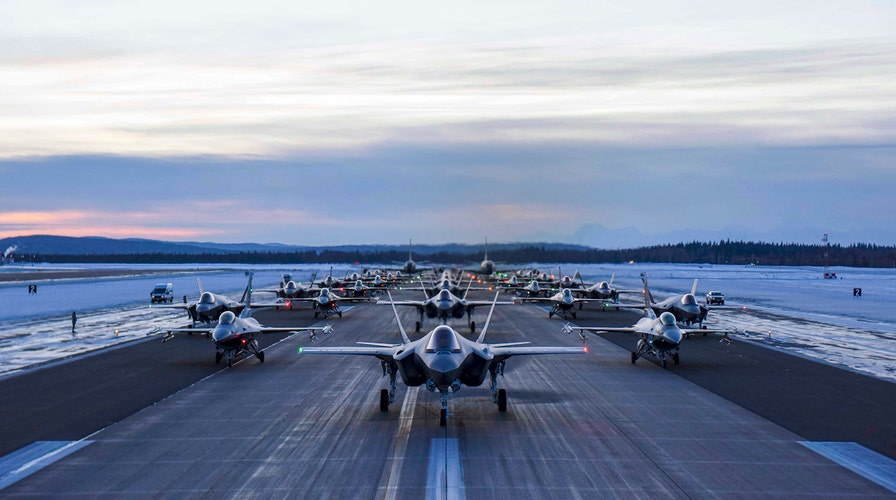Fox News Flash top headlines for January 14
Fox News Flash top headlines are here. Check out what's clicking on Foxnews.com.
Just in case Santa Claus and his elves wound up needing military protection from an attempted hostile intrusion in the North Pole, the U.S. Air Force was ready with F-35 and F-16 fighter jets poised for rapid attack.
The service’s 354th Fighter Wing at Eielson Air Force Base, Alaska, is using the shortest days of the year to prepare for war in the Arctic under darkness and amid harsh weather conditions. Every flying unit at the base was assembled on the runway for what the Air Force calls an Elephant Walk. More than thirty fighters and two refueling aircraft participated in the exercise.
"The elephant walk isn’t only to practice our abilities to respond quickly," Col. David Skalicky, 354th Operations Group commander said in an Air Force report. "This is to show our Airmen who work behind the scenes what Eielson AFB is about, it’s about showing our strength in the arctic arena."
AIR FORCE TO TEST FIRE FIGHTER JET-CONFIGURED LASER WEAPONS POD FROM THE GROUND

Aircraft assigned to the 354th Fighter Wing and 168th Wing park in formation on Eielson Air Force Base, Alaska, Dec. 18, 2020. Over 30 aircraft were quickly generated and prepared to launch in an effort demonstrating the readiness capabilities of the 354th Fighter Wing and the 168th Wing. (U.S. Air Force photo by Senior Airman Keith Holcomb)
The formation included eighteen F-35A stealth fighters, twelve F-16s and two KC-135 Stratotankers.
Having an Arctic presence is something of greatly increased significance for the Air Force as more countries rapidly seek to establish influence, compete for resources and strengthen a presence in the region. Should there be a need for any kind of rapid response military capability if, for instance, Santa’s reindeer were suddenly overwhelmed by hostile enemy fire, the Air Force would quickly leverage its proximity to the region through Alaska to establish a rapid presence.
In preparation for these kinds of contingencies, the F-35 jet fighter was specifically tested in rigorous climatic testing to ensure it can operate in the harshest of conditions, including the ability to fly missions at 40-degrees below zero Fahrenheit. The cold weather testing took place several years ago as part of an Arctic warfare preparation exercise to test the jet amid high winds, solar radiation, humidity, rain, ice buildup and vortex icing and snow. The Aircraft "flies in place" on a tether during the test and is blasted with snow, ice and extreme sub-zero temperatures. To survive the harsh conditions, pilots are given special thermal underwear and an extra thermal outer layer, all of which is added to by a snowsuit. Pilots also wear arctic boots, heavy winter socks and specially engineered winter flying gloves.
CLICK HERE TO GET THE FOX NEWS APP
The climatic testing was in part intended to ensure that weapons systems such as the F-35s’ 25mm gun or EO-IR cameras would not be disabled by ice or freezing temperatures. Warming systems such as aircraft electronics or engine heat could help defrost areas of the fuselage and related sensor systems. However, there are still large differences in temperature between the aircraft and surrounding air that could increase radar signature and possibly decrease stealth effectiveness. As a result, heat-seeking weapons may have a better chance of hitting their targets should the aircraft’s warmth distinguish the systems from outside temperatures.
-- Kris Osborn is the Managing Editor of Warrior Maven and The Defense Editor of The National Interest --









































